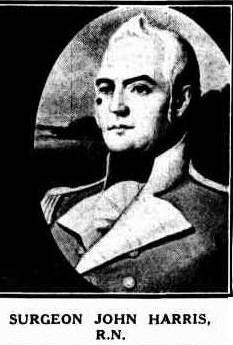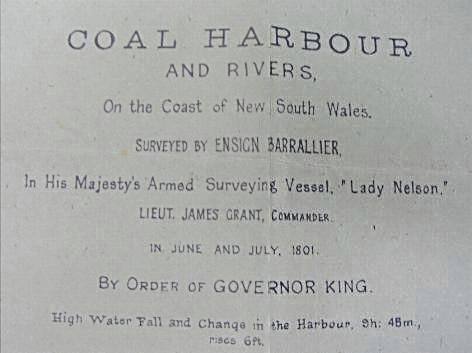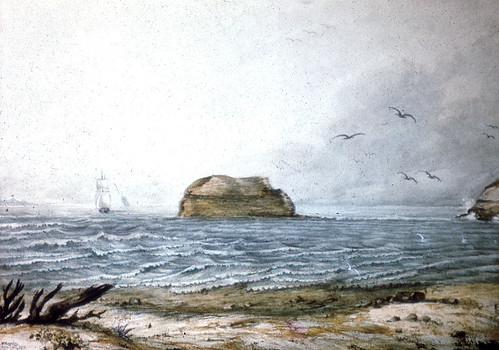Expedition to Newcastle and Hunter River
1801
Lady Nelson in 1801
Following is an extract from Memoirs of Hydrography outlining the movements of the Lady Nelson in 1801.....Soon after arrival at Sydney, the Lady Nelson was paid off, and Lieutenant Grant appointed to the command of the armed ship Supply; but that vessel proving unseaworthy, he again resumed his first charge, and on March 6th, 1801, left Sydney with the Bee (a decked launch) as tender, under orders from the governor, Captain P. G. King R.N., to make a thorough examination of Bass's strait. The Bee sailing as a sea-boat, soon returned to Sydney, and the Lady Nelson continued alone. Mr. Cayley, a botanist, who had been sent out from England by Sir Joseph Banks, accompanied Lieutenant Grant, who also had with him Mr. J. Murray, a mate R. N., and Ensign Barralier the surveyor of the colony
Jervis bay was examined, and many interesting observations recorded as to the natives, their habits etc. Continuing to the southward, the northern coast of Bass's strait was explored, from Wilson's promontory to Western point, a distance of 70 miles; after which, Botany Bay, to the southward of Sydney, was returned to.
Having taken on board Lieut-Colonel Patterson (after whom the river Paterson was called), in company with the schooner Francis, the Hunter river was explored. [3]
Prior to departure for the Hunter River Governor King was presented with a silver snuff box by Lieut. Grant - 'The oval box is engraved with the initials 'PGK'. The underside of the lid is inscribed: 'Lt. Grant to Governor King June 4 1801'.
 Image: Governor King's snuff box
- National Museum of Australia
Image: Governor King's snuff box
- National Museum of AustraliaExpedition
The expedition to the Hunter River included Lieut-Colonel Paterson, Lieut. James Grant, J. Murray, R.N., Ensign Barralier, George Cayley and Dr. John Harris. After the Francis returned to Sydney with a small cargo of coal, artist John William Lewin joined the expedition.Departure from Sydney
The object of this voyage was to make a survey of the river, to gain a knowledge of its natural productions, and whatever else might appear worthy of observation. Having all things in readiness, we set sail on the 10th of June, with the Francis schooner, which latter vessel was to be loaded with coals. With Colonel Paterson, we received on board Dr. Harris, Surgeon of the New South Wales Corps, Ensign Barreillier (the Surveyor), and a number of workmen and labourers, for the purpose of cutting and sawing timber, digging and loading coals, and other necessary works. With us likewise went one of the natives, named Bangaree.
At the mouth of the harbour we fell in with the ship Cornwallis, having convicts on board from England; and on the 11th at noon we had an observation in the lat. 33 35' S. the north head of Broken Bay bearing W. by S. distance 10 or 12 miles. [1]
Instructions from Governor King
Lieutenant Paterson was under orders from Governor King to collect useful information about the area -Memorandum by Governor King ( King papers)[1]
9th June 1801
Objects to which Governor King requests Lieut-Colonel Paterson, Lieut. Grant, and the other gentlemen going in the Lady Nelson to Hunter's river will pay a particular attention - The nature of the soil in general. Whether the grounds are overflowed, either by high tides or by land floods Whether the place may be thought healthy or unhealthy on account of the mud banks which I am told surround the sides of the river. If the water is sweet and good The size of the trees and whether there is plenty of timber for building, stone, limestone, or shells How far it may be practicable for vessels to frequent that port with safety, the quantity of coals that may be procured there, the facility of procuring them, and what proportion of labour would be necessary to keep a supply ready for vessels going thither for that article. To assist the gentlemen in forming an idea on this head, a miner who has been there before will accompany them. To examine where the most eligible place would be to form a settlement, both with respect to procuring coals and/or agricultural purposes
Hunter River
On 14th June 1801 Lieutenant Grant and Dr. Harris disembarked at Coal Island (Nobbys) and raised the new Union on top of the island.....
15th June 1801 - The Lady Nelson was taken round Pirate Point to the small bay with fresh water named by Colonel Paterson Freshwater Bay
17th June 1801 - James Grant and Colonel Paterson examined Ash Island
19th June 1801 - Lieut-Col Paterson sighted natives in the distance at Hunter River
22nd June 1801 - Francis Barralier and Mr. Grant sounded the entrance to the Hunter river
29th June 1801 - Lieut- Paterson, Mr. Harris and Mr. Lewin made an excursion of seven days using a launch and small boat belonging to Mr. Harris
30th June 1801 - They proceeded about 14 miles up Hunter river
1st July 1801 - Lieut-Paterson, Mr. Harris and Mr. Lewin arrived at Schank's Plains.


Lieut-Col. Paterson later informed Governor King of the excellent coal available at Coal Island (Nobbys) and the northern point of land he named Colliers Point which can be seen on the map above situated bottom left near Sheep Pasture Hills (The Hill)
A settlement under orders of Corporal John Wixtead was established at Newcastle and convicts were sent soon afterwards to begin mining the coal.
Lieutenant Grant's Return to England
The Lady Nelson returned to Sydney July 25th, 1801, and Lieutenant Grant sailed November 9th, of the same year in the brig Anna Josepha, laden with coal and timber, by way of Cape Horn and Falkland islands, for the Cape of Good Hope. After a wild passage, during which, the crazy vessel was becalmed for six weeks in the vicinity of Tristan d' Acunha, Table bay was arrived at April 1st, 1802, and shortly afterwards Lieutenant Grant embarked for England in H.M.S. Imperieuse. The first coal brought from Australia in the Anna Josepha, realised 36 rix dollars a ton, at the Cape - Memoirs of Hydrography.
Notes and Links
1). George Cayley and Francis Barralier both arrived on the Speedy in 1800.
2). Nobbys c. 1807 painted by John William Lewin. A similar work entitled The Lady Nelson and Francis Schooner entering Hunter's River or Coal River, published January 10 1804 by T. Egerton, Whithall can be seen at Lewin Wild Art Exhibition, State Library of NSW
References
[1] Philip Gidley King...Historical Records of New South Wales. Vol. IV. Hunter and King. 1800, 1801, 1802. Edited by F. M. Bladen. p. 391[2] Grant, James, Voyage of Discovery to N.S.W. in the Lady Nelson in 1800-2
[3] Memoirs of Hydrography
↑
